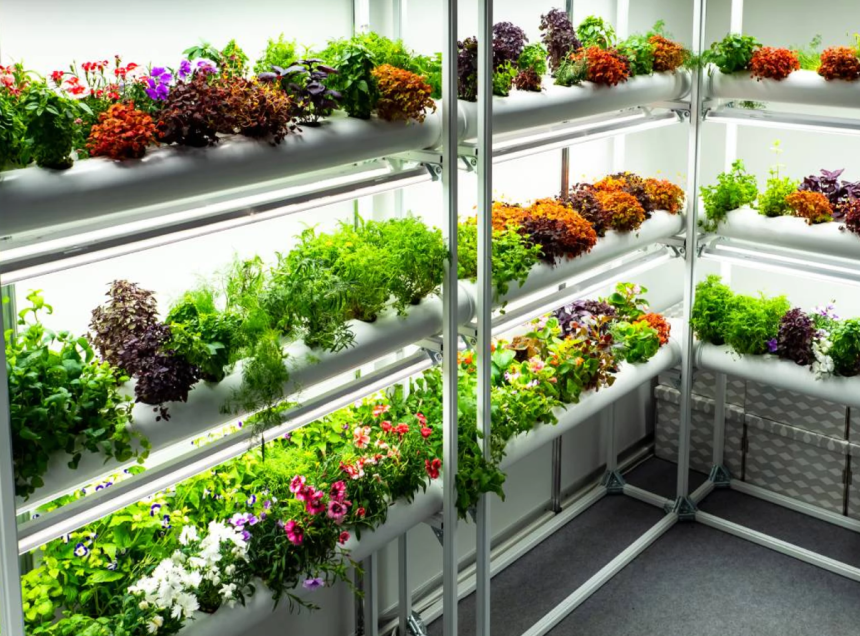Embarking on the journey of cultivating your crops through hydroponics can be an exciting and rewarding endeavor for any aspiring gardener. This innovative method of growing plants without soil opens up a realm of possibilities, offering more control over environmental factors and potentially increasing yields. In this guide, we’ll explore the basics of starting a hydroponic garden from the perspective of an ordinary grower, highlighting essential steps and sharing insights into using LED grow lights without delving too deeply into technicalities.
Getting Started: Understanding Hydroponics
Before delving into the intricate details of hydroponic gardening, it is of utmost importance to fully comprehend the underlying principle that serves as its foundation. Hydroponics is a revolutionary technique that entails the cultivation of plants in a meticulously crafted nutrient-rich water solution, thereby eliminating the conventional reliance on soil. By adopting this innovative approach, growers are empowered with unparalleled control over the nutritional intake of their plants, facilitating enhanced absorption and utilization of essential nutrients. Moreover, the absence of soil allows for precise manipulation of environmental factors, enabling growers to create the perfect conditions for optimal plant growth, ensuring bountiful yields and thriving crops.
Step 1: Choose Your Crops Wisely
Selecting the most suitable crops for your hydroponic system is an absolutely crucial initial step. It is important to carefully analyze and take into consideration various factors such as the prevailing climate conditions in your area, the amount of available space you have for cultivation, as well as your personal preferences. By doing so, you can guarantee that the crops you choose to grow in your hydroponic setup perfectly align with your specific goals and objectives, whether you are aiming to cultivate aromatic herbs, nutritious leafy greens, or even juicy and vibrant tomatoes.
Step 2: Set Up Your Hydroponic System
The heart of any hydroponic endeavor lies in the setup of the system. There are several different types of hydroponic systems that you can choose from, depending on your space and experience level. Some popular systems include nutrient film techniques, deep water culture, and aeroponics. Each system has its own advantages and disadvantages, so it’s important to do some research and choose the one that best fits your needs.
Once you have chosen a hydroponic system, it’s time to assemble all the necessary components. This will include containers or trays to hold the plants, pumps to circulate the nutrient solution, and a nutrient solution itself. Make sure to choose containers that are the right size for your plants and that have proper drainage. The pumps will help to circulate the nutrient solution, ensuring that your plants receive the necessary nutrients. Lastly, the nutrient solution is a crucial part of the hydroponic system as it provides all the necessary nutrients for the plants to grow.
Step 3: Integrate LED Grow Lights
While natural sunlight is the preferred source of light for plant growth, many growers choose to incorporate LED grow lights as a supplement or alternative. LED grow lights are known for their energy efficiency and ability to provide a spectrum of light that promotes plant growth. When integrating LED grow lights into your setup, it is important to consider factors such as the intensity of the light, the duration of exposure, and the appropriate distance between the lights and the plants. By carefully considering these factors, you can optimize the growth and development of your plants using LED grow lights.
Enhancing Growth with LED Grow Lights
LED grow lights have become a staple in indoor gardening, offering a reliable light source for plants. As a regular grower, it’s essential to strike a balance between natural and artificial light for optimal results. Here are some tips for using LED grow lights effectively:
Tip 1: Understand Light Requirements
Different crops have varying light requirements. Research the light needs of your chosen plants and adjust the LED grow lights accordingly. Experiment with light schedules to find the optimal duration for promoting healthy growth.
Tip 2: Maintain Appropriate Distance
Positioning LED grow lights at the right distance is critical. If the lights are placed too close, your plants may experience heat stress, which can be detrimental to their health. On the other hand, if the lights are placed too far, your plants may not receive sufficient light, hindering their growth. To determine the ideal distance, it is recommended to follow the manufacturer’s guidelines.
Additionally, it is crucial to monitor your plants’ responses closely and make necessary adjustments accordingly. By carefully observing how your plants are reacting to the light, you can ensure that they are receiving the right amount of light and avoid any potential issues that may arise.
Tip 3: Monitor Nutrient Levels
In a hydroponic system, maintaining optimal nutrient levels is of utmost importance. LED grow lights play a significant role in enhancing nutrient absorption, thereby contributing to the healthy growth of your plants. To ensure your plants thrive, it is essential to regularly monitor and adjust the nutrient solution. By taking this proactive approach, you can rest assured that your plants are receiving the necessary nutrients to support their robust and vigorous development.
Brands in the Hydroponic Landscape
In the world of LED grow lights, brands like Batagrowlight and Boyagrowlight have gained recognition for their quality products. These manufacturers provide a range of lighting solutions suitable for various crops. Remember, it’s not about the brand but the specifications that align with your hydroponic setup.
Troubleshooting and Fine-Tuning
As with any gardening method, challenges may arise. It is important to closely monitor your plants for any signs of nutrient deficiencies, pests, or diseases that may occur. By doing so, you can ensure that your plants are receiving the proper nutrition and care they need to thrive. In addition, it is crucial to regularly adjust your hydroponic system and LED grow light setup based on the specific needs of your plants. This will help provide them with the optimal growing conditions necessary for a successful harvest. By observing your plants regularly and taking quick interventions when necessary, you can maximize the chances of achieving a bountiful and rewarding harvest.
Conclusion
Starting a hydroponic garden as a regular grower is an enriching experience. By understanding the basics, integrating LED grow lights strategically, and fine-tuning your approach, you can cultivate a thriving crop. Remember, the journey is as crucial as the destination, so enjoy the process of nurturing your plants and witnessing the fruits of your labor. Happy hydroponic gardening!














